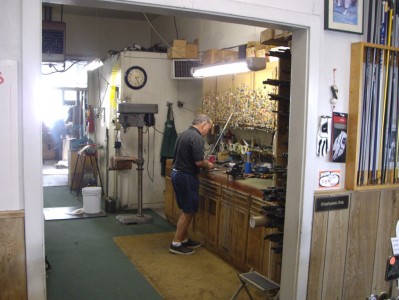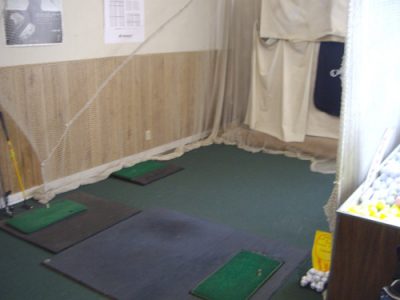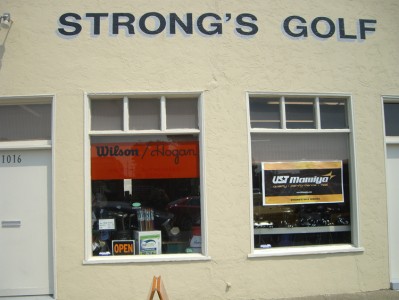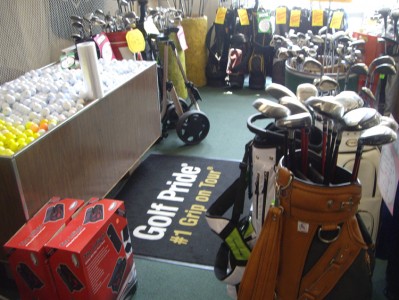Athletes in most sports are always looking for an edge, or a way to tweak their game so they can become more successful. This perhaps is most noticeable in the game of golf. Golfers are constantly changing. If it’s not their swing, stance or grip, then it’s their equipment, like clubs or balls. Tiger Woods, arguably one of the best players of all time, seems hardly satisfied the past few years with his swing. And here’s what Ireland’s three-time
Major Champion Padraig Harrington had to say about the sport. “I believe you have to continually change to stay the same in golf,” he said on a recent TV show.
Yes, the only real constant in golf is change. So where am I going with this, you ask?
Well I’ve done a few stories focusing on some of our local pros that grew up in Sonoma County. I’ve also featured some of our bright young high-school stars. So for a change, this will be a feature on a gentleman that grew up just outside of Sonoma County and who actually played on the European Tour for a short time.
Jim Strong, 62, went to high school in Ukiah and played on the Wildcats’ golf team. After graduating he went on to play four years of varsity golf for Arizona State University.
Jim is married (Bonnie) and has three grown children, Steve (30), Stacey (28) and Scott (24).
Strong said the strength of his game has always been putting.
“My putting was the main thing that saved me,” he said. “I’d miss a few, but I’d make a lot of putts from every distance. I was a mediocre chipper, terrible driver of the ball and a great iron player.”
So I asked Jim what, or who, got him interested in golf.
“No one really,” Strong said. “My dad (David) played golf, and one day when I was around seven I found an old cutoff club in our garage. I took a few of his used golf balls from his bag and headed to the school across the street. The whole school was surrounded by grass. So I went out and started hitting balls.”
Jim said the only instructions he ever got, other than high school and college coaches were from his dad.
“I didn’t have any lessons,” he said. “My dad showed me a few things, like the grip and stuff, and then I kind of taught myself. I just went out and hit balls.”
Once Strong graduated from ASU he had some decisions to make. He knew he was a pretty good golfer, but he wasn’t sure if he was good enough to become a professional player. So he went to Plan B.
“I knew I wasn’t good enough to play on the PGA Tour so I didn’t try ‘Q’ School, Strong said. “But I also knew I wanted to try and become a professional player. So I headed to Europe to try the European Tour. I played there for about six months. Over there, you traveled to a tournament and they would have qualifying rounds on Monday for the few remaining spots for the tournament that would start mid-week. I didn’t have a sponsor and I didn’t have a lot of money. I made the first cuts sometimes but struggled to make the second cut. I also wasn’t playing my best golf when I was over there, which didn’t help matters.”
Jim said the courses were quite different than they are now-a-days. He said they weren’t as fabricated.
“You pretty much just had to follow the lay of the land,” Strong pointed out. “It was like they’d find a spot and stick a green there. Then they would walk around some more and find another good spot for a green. They would go around the corner and find another great spot just by following the flow of the land. Nothing was manicured, I can tell you that.”
Strong recalled there were a lot of soon-to-be big name guys playing the European Tour, like Craig Stadler, Jerry Pate and Gary Player, but at that time only Player was well known.
After deciding to return home Strong faced another decision about his golf future.
“I remember telling myself, ‘You know what, I’m good, but I’m just not that good,’ he recalled. ‘I don’t know if I want to beat my head against the wall until I’m, you know, 35 years old, and then find out I’m going nowhere. You got to want to do it. And it didn’t feel like I wanted it enough.’”
His dream of playing professional golf had come to a close, but Strong wasn’t about to give up being a part of the game he’d grown to love.
“When I was at Arizona State I worked for a little golf course (Papago GC) part time,” Strong reminisced. “They had a little repair shop in the back. A lot of touring pros would come by during the winter and practice. I mean, Johnny Miller would come by and fix his clubs. Sometimes I’d even work on their cars. There wasn’t a big fancy tour bus back then. So the pros had to tweak their clubs themselves. They’d be in there changing lofts and faces of woods, and shafts, and all kinds of stuff. I knew I liked working with my hands so I paid attention and learned a lot.”
That’s where Plan C originated.
Strong decided to do the next best thing than playing golf. In 1976 Jim opened Strong’s Golf Service.
“Yeah, I started from scratch back in 1976,” he said proudly. “I was way down off Santa Rosa Ave. by Todd Road. I figured I would open up a shop and try and grow with the city. Back then the population of the city was around 60,000.”
Strong was just trying to make rent when a gentleman name Lee Farris walked into his shop.
“I was starving at first, but got a huge hand from Lee Farris, who owned the Sebastopol Golf Course,” Strong said. “Lee brought me a bunch of clubs to work on. He was the very first guy I did business with. He was unbelievable. And after a while things began to get better. I started re-facing woods and changing shafts. That was back when you had wood woods. That was a real skill. Now I call it the glue and go game. It doesn’t take as much skill.”
Jim can do just about anything in his shop, anything that is, but give lessons.
“If a customer comes in and hits some balls into the net, and is struggling with something, I might give him a pointer if he asks me what I think.”
Strong has always understood the importance of helping our local kids learn the game of golf. He’s donated clubs to numerous programs and has also given a few clinics at some of your local schools.
Jim has since moved his business to a location on South A Street in Santa Rosa.
Strong didn’t hesitate when asked who his favorite pro was.
“That’s easy,” Strong replied. “Arnie. The guy’s a 10. He had more time for everybody else than he had for himself. He just goes out and would be nice to everyone. It’s almost hard to explain. He was a guy that never turned down an autograph and I doubt if he ever charged for one. I got my picture taken with him over at Silverado in Napa. I think I was 14. It was during a tournament he was playing in. He’s walking between greens and I went over and asked him, “Can I get my picture taken with you Mr. Palmer? And he stops right there and poses right next to me, takes the picture and then he thanks me. Back then you could take cameras on the course and things like that during the tournament, but now they don’t let you.’”
Strong thinks the pros should emulate Palmer more.
“Most of the pros on tour now forget that they are there to entertain us, he said. “We’re the people that buy their products they indorse and are paying their salaries. I think they should take the time to thank the fans. In general they don’t do that. They’re too worried about their money, and this and that. I think if some of them would lighten up they might even shoot better. I mean, take the Phoenix Open for example. On that short par 3 everyone is yelling and cheering for the players. They use to have caddie races after the pros had finished hitting their shots. I guess they had to stop that before someone got hurt. But the pros appear to be having fun. That tournament draws over 200,000 fans and the pros seem to score well besides all the commotion. When Phil Mickelson isn’t playing well he takes his lumps but he still talks with people and give out autographs and gloves. There are not many pros out there that will do that.”
Strong thinks one of the top young players to keep an eye on is Rickie Fowler.
“Rickie Fowler seems pretty friendly,” Strong said. “I think if he’d win more kids would start playing more. The kids can relate to him. He’s an X Gamer guy, and a skateboarder.”
Strong shared a story of when he first saw Fowler.
“My son Steve and I flew down to Los Angeles, met my daughter Stacey, who was attending the University of Southern Cal, and we drove down to San Diego’s Torrey Pines, which was hosting the U. S. Open in 2008. My daughter played on the USC NCAA soccer championship team, but that’s another story. Anyway, we’re watching a practice round and I didn’t know who Fowler was. He’s over there fooling around and chipping with some other young guys. So I say to Stacey, ‘Hey look at that guy, he looks like he’s only 15. I wonder if he’s going to caddy for someone, or if he’s actually going to be playing? Of course, he wasn’t wearing that big goofy hat that he wears now. He had a visor on and when he took it off he looked like he was about 12. We found out later he was playing because he’d won a qualifier for the Open.’”
Since he mentioned Stacey, Jim’s youngest son Scott played golf for his high school team, and Steve earned All-Conference honors in golf at U.C. Davis.
Strong believes golf architects are making the courses too long, and too tough.
“There are two problems when you lengthen or design long golf courses,” he said. “The first is the large maintenance cost, with all the watering, manicuring and man power. That creates a much bigger overhead, and now they have a bigger nut to crack. So they have to charge more, and it makes the course harder. That’s great for the pros, but I’m talking about the average golfer. It also takes longer to play. Players are finding out they don’t want to spend five or six hours on a golf course. That’s not very appealing to the younger players.
And second of all, why does everyone want to play the back tees? I’d rather play from a tee where I might be able to drive a par 4 and have a shot at an eagle. Now that sounds like fun to me. Why play from the back tees and be lucky to break a 100? Then they put those huge bunkers out there and most of the players can’t get out of them with one swing. I can, but most can’t. That’s where the whole game has evolved. They’re making it tougher so it’s not as much fun. That’s why play is down.”
Jim still enjoys playing golf and rotates between Rooster Run and Bennett Valley. Every so often he’ll also throw in either Bodega or Adobe Creek.
It’s hard to believe Jim Strong got started playing golf with a cutoff club he found in his garage. I just wonder if that’s why he’s turned out to be a professional club mechanic, cutting clubs down, adding length to others, or just tweaking the loft or face of a club for someone to help improve their game. That just goes to show you, some things never change.





